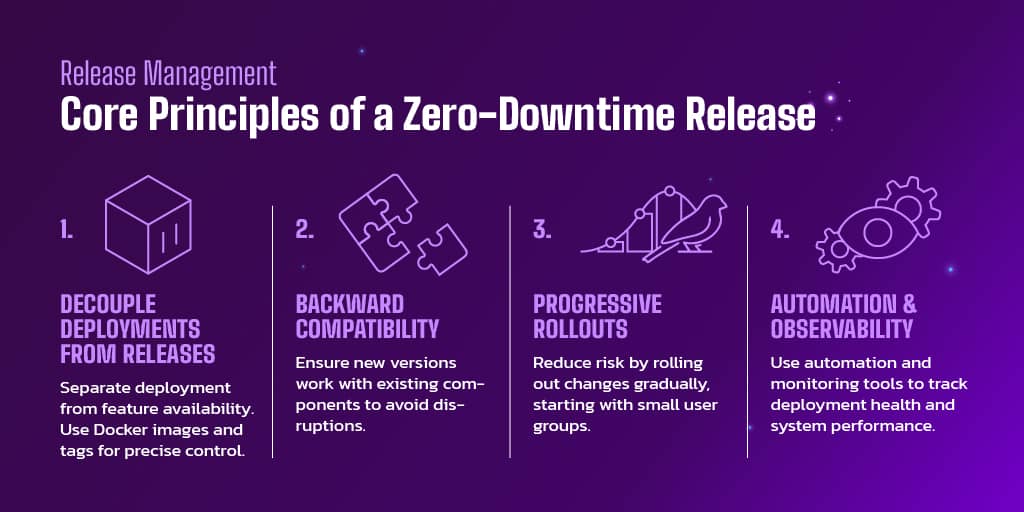Key Highlights
- Learn the best Release Strategy to implement software updates without service interruption
- Master containerization for efficient version control and deployment
- Set up monitoring tools to detect and resolve issues quickly
- Implement reliable rollback procedures during system changes
- Learn to spot and prevent deployment issues with our checklist
A one-minute failure in our online store's checkout system resulted in the loss of 100,000 transactions, highlighting the critical importance of zero-downtime deployments. We started with a traditional Beanstalk Windows Server setup that required creating entirely new environments for each deployment - a process that was both resource-intensive and prone to errors.
Our transition to Docker within the existing Beanstalk environment created a more efficient solution allowing incremental deployments without needing new environments. We proved this approach's effectiveness through a successful proof of concept using a GoLang HTTP service, achieving zero-downtime deployments. This experience deepened our understanding of what zero-downtime releases mean for modern applications.
Understanding Zero Downtime Releases
Zero-downtime releases enable software updates without any service interruption for users. In our experience, this approach eliminated the minute-long downtime previously encountered during rollbacks with our old Beanstalk setup.
The Modern Application Imperative: High availability is now fundamental for modern applications. With massive request volumes, even momentary disruptions can result in major financial losses and damage to reputation. Our checkout system, which processes 100,000 requests per minute, perfectly illustrates this critical need.
Key Implementation Challenges: Organizations often face several obstacles when implementing zero-downtime deployments. One is the complexity of managing interdependent infrastructures. Manual processes remain time-consuming and prone to errors due to insufficient automation. Testing coverage frequently falls short, leading to production issues. Communication gaps between development and operations teams create coordination problems. Additionally, maintaining up-to-date documentation about processes and configurations often proves challenging.

Core Principles of a Zero Downtime Release
Now that we understand deployment challenges, let's examine the key principles behind zero-downtime releases.
Crafting a Reliable Release Strategy with the Right Deployment Methods
Now that we've established core principles, understanding deployment strategies is indispensable, for a successful release strategy, as they directly impact stability and user experience.
Let's examine different deployment strategies, their implementation and best practices to each of them as they offers distinct advantages for specific scenarios. For a more detailed breakdown of each strategy, check out our in-depth guide.
Blue-Green Deployments
A dual production environment strategy where you switch between versions. Requires automated health checks, synchronized data between environments, clear database migration plans, and defined rollback procedures. Best suited for:
- Large, monolithic applications where entire system updates are needed
- High-traffic applications that cannot afford partial downtime
- Systems where complete testing of the new environment is required before switching
- Scenarios requiring fast rollback capabilities
Canary Releases
Gradual rollout to select users before full deployment. Focus on measurable success criteria, detailed monitoring systems, automated anomaly detection, and controlled user base expansion. Best suited for:
- Applications with a high risk of user impact
- Features that need real-world validation
- Systems with diverse user segments
- Scenarios requiring careful performance monitoring
Feature Flags
Runtime feature toggling without redeployment. Maintain thorough documentation, implement regular cleanup processes, use consistent naming patterns, and enforce proper access controls. Best suited for:
- Applications requiring granular control over feature rollout
- Systems needing quick feature disablement without deployment
- A/B testing scenarios
- Environments with multiple customer segments requiring different features
Database Migrations Without Downtime
Strategy for updating database schemas while maintaining service. Implement backward compatible changes, use temporary tables for large migrations, ensure proper data synchronization, and maintain comprehensive rollback procedures. Best suited for:
- Systems with large-scale databases that cannot afford interruption
- Applications requiring frequent schema updates
- Services with strict uptime requirements
- Scenarios involving critical data that must remain accessible
Rolling Updates
Sequential instance replacement with zero downtime. Implement robust health monitoring, balanced load distribution, distributed session handling, and careful resource allocation. Best suited for:
- Systems requiring continuous availability during updates
- Applications with stateless components
- Microservices architectures
- Environments with limited resources that can't support parallel deployments
Traffic Management
Strategic traffic routing during deployment phases. Deploy clear routing policies, implement failure safeguards, establish timeout protocols, and maintain comprehensive routing analytics. Best suited for:
- Applications with high-traffic loads requiring precise load balancing
- Microservices architectures with complex routing requirements
- Systems requiring geographical traffic distribution
- Applications needing sophisticated request filtering and routing
Having explored these deployment strategies, we must now examine how automation is required for their effectiveness and reliability.
The Role of Automation in Zero Downtime Releases
CI/CD Pipelines: Automated integration and delivery pipelines help ensure consistent and reliable deployments, enabling automated testing and validation before each release, and minimizing the risk of downtime caused by human errors.
Infrastructure as Code (IaC): Infrastructure as code enables versioning and automation of identical Docker environments, ensuring consistency between development and production while facilitating rollbacks without causing service interruption.
Automated Rollback: Automated rollback systems enable rapid reversion of problematic changes without service interruption, maintaining availability even in failure scenarios.
To maintain zero-downtime deployments, robust monitoring and incident response protocols must work alongside automation. Let's examine how these monitoring strategies complement automation to ensure reliable system operation.
Monitoring and Incident Response
These three elements work together to ensure that any issues during a release can be detected and resolved quickly, minimizing or completely eliminating system downtime.
Real-time Observability: Integrating tools like Prometheus and Grafana enables real-time monitoring of system behavior during deployments, allowing teams to quickly spot anomalies that might affect users.
Alerting Mechanisms: Setting up alerts and real-time notifications through tools like Golive helps teams monitor unexpected behaviors and environment changes, enabling proactive responses to potential issues before they cause significant downtime.
Quick Response: Docker simplifies rollbacks, letting teams swiftly restore a stable version if deployment issues arise.
While monitoring and incident response are fundamental, teams must also prepare for common challenges in zero-downtime deployments. Based on our experience, we've identified several common pitfalls that teams often overlook and must actively prevent.
Common Pitfalls and How to Avoid Them
- Ignoring Rollback Plans: A critical aspect often overlooked is having solid rollback procedures. Our experience with Beanstalk taught us this the hard way, as reverting changes required complex environment switches. Docker containers significantly improved this by allowing instant version switching through image tags, making rollbacks quick and reliable.
- Insufficient Testing: Comprehensive testing is needed for zero-downtime releases. We test Docker containers thoroughly in production-mirrored staging environments, running both load tests and integration checks. This approach ensures smooth deployments with uninterrupted service.
- Underestimating User Impact: A common oversight is not accurately assessing the computational resources needed to handle user load during deployments. When systems are undersized, they can become overwhelmed during version transitions, leading to performance degradation or complete service interruption. Our experience with processing 100,000 requests per minute taught us to carefully plan resource allocation and scaling strategies to maintain system stability during deployments.
Let's now review a checklist that summarizes key points for zero-downtime releases and provides a pre-deployment verification framework.
Final Checklist for Successful Zero Downtime Releases
- Pre-Release Testing: Follow our comprehensive release checklist to ensure thorough testing in staging environments that mirror production conditions.
- Documentation and Communication: Maintain up-to-date documentation and ensure clear communication across teams. Check our free e-book Mastering Communication with Release Dashboards.
- Post-Release Verification: Monitor system performance and user experience immediately after deployment.
Conclusion:
Achieving zero-downtime deployments requires a comprehensive understanding of the entire release management process, from planning to execution. Success depends not only on continuous learning and experimentation but also on mastering the intricate relationships between development, testing, and operations. The combination of modern tools with a strong culture of automation, monitoring, and process ownership is required for delivering software quickly, safely, and reliably.
Key Takeaways
- Deployment Pipeline Design: Establish a robust CI/CD pipeline that automates testing, validation, and deployment.
- Monitoring Implementation: Set up comprehensive monitoring systems to track key performance metrics and detect errors in real-time.
- Infrastructure Scalability: Set up dynamic auto-scaling and load balancing to manage deployment traffic effectively.
- Version Control Strategy: Use semantic versioning and maintain clear, detailed changelogs for each release.
- Risk Mitigation Plan: Create and verify rollback procedures to ensure swift recovery if deployment issues arise.
Transform your Test Environment Management with Apwide Golive:
Leading companies have already Golive as part of their DevOps toolchain:





Free trial / Free forever up to 10 Jira Cloud users!

